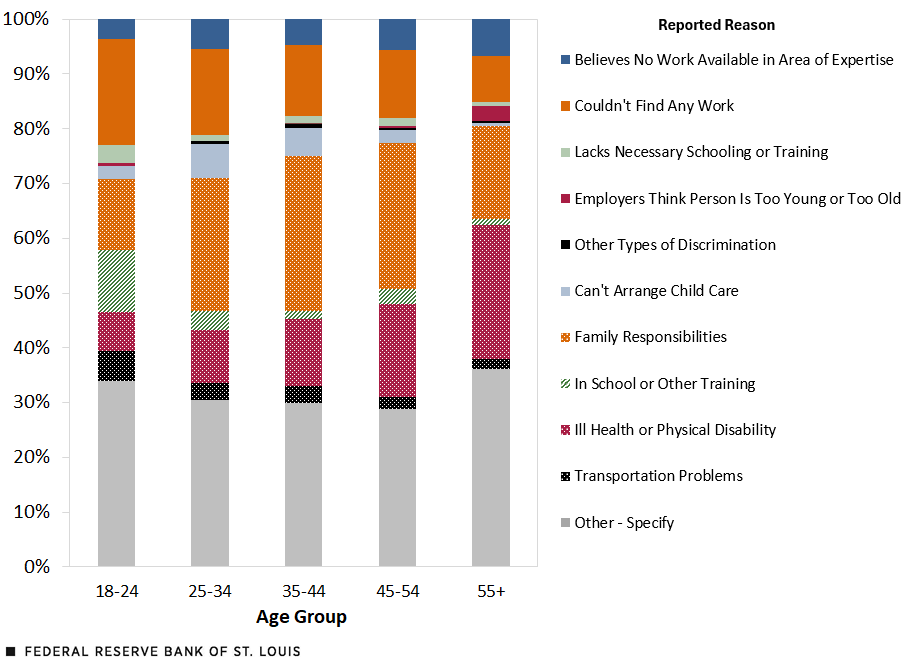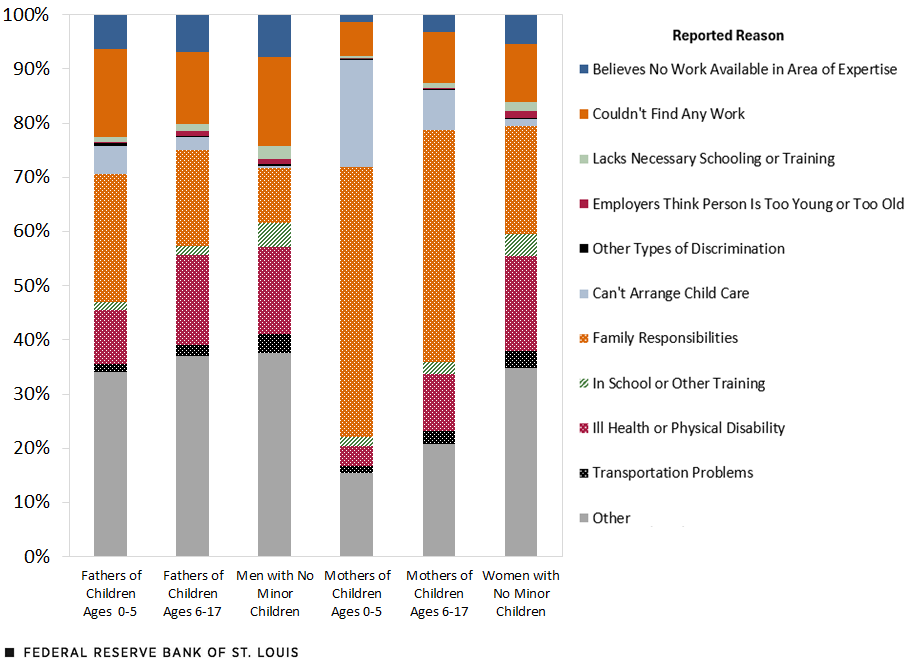Family Care, Health Issues Remain Top Workforce Barriers
In 2024, on average, approximately 3.7 million adults wanted a job but didn’t have one and had not looked for employment in the past four weeks.The WNLOOK variable from IPUMS CPS is used throughout this blog post. The universe is persons who are not working, have not looked for work within the past 4 weeks, but do want a job. They are not considered unemployed because they have not actively looked for a job within the past 4 weeks. They may or may not have accepted a job in the previous week had one been offered. The average number of total nonfarm job openings, at the time, was 7.8 million. If everyone in the first group was actively looking for a job, a substantial number of job openings could have been filled.
Why aren’t those adults looking for work? Barriers to workforce participation can make it more difficult for people to find and retain employment. Previous research has shown caring for a family or a household and poor health are common reasons. Organizations and communities that understand these barriers and work to address them can be more competitive, retain talent and promote workforce resilience—a worker’s ability to adapt and even thrive in the face of challenges. So, why are some people not fully engaged in the workforce, especially when they want to be?
I set out to answer that question in this blog post, the first of two. The U.S. Census Bureau’s Current Population Survey (CPS) asks the following question: What is the main reason you were not looking for work during the past four weeks?Responses are open-ended, and then the interviewer categorizes responses as one of 10 mutually exclusive options. Those that do not fit are classified as “other.” For example, “too young—his father wouldn’t let him.” Public CPS files do not go into more details regarding the other category. For more information about the “other” category, see the WNLOOK variable in IPUMS CPS, University of Minnesota. For adults who are not in the labor force and do not want a job, this question isn’t asked.
Respondents who were not working and had not looked for work in the past four weeks but who wanted a job answered this question. I removed current students, those who were unable to work, retired adults and minors from the sample.
Family Responsibilities, Health Issues Are Major Barriers
The top three reasons these adults were not looking for work in 2024 were “other,” family responsibilities and ill-health or physical disability (i.e., health issues), together representing over two-thirds of reasons given (32%, 21% and 15%, respectively).Economists refer to the subgroup of adults who answer this question and are additionally available to work now and have looked for work in the past 12 months as marginally attached workers. A further subgroup is those who respond that they were not looking because of a job market-related reason, lacking education or training, or discrimination. Combining these “discouraged” reasons was 21% of the overall weighted sample. Importantly, while there were notable differences during recessions,During the Great Recession, “couldn’t find work” and “lacks necessary schooling/training” spiked, becoming the top two reasons indicated in 2010, accounting for about 50% of responses. During the COVID-19 recession the “other” reason spiked, accounting for 45% of responses. trends related to workforce barriers have remained similar over the past 20 years.
Next, I grouped the results by age group: 18-24, 25-34, 35-44, 45-54, and 55 and older. Again, the primary reason was “other” in each age group, indicating the responses available to respondents did not capture their main reason for not looking for work. (See figure below.) Family responsibilities were the second most common reason for 25- to 54-year-olds, perhaps pointing to their status as the “sandwich generation,” which cares for their own children and aging parents, often at the same time. Being unable to find work was the second most common reason listed for the youngest adults, and health issues were second for the oldest adults.
Other age-related differences were evident. Adults ages 55 and older were more likely than other adults to indicate they weren’t looking for work because employers thought they were too old. Adults ages 18-24 were much more likely to indicate they weren’t actively looking because they were in training.
Primary Reason for Not Looking for Work in 2024

SOURCES: IPUMS CPS and author’s calculations.
NOTE: The 2024 responses are averages of the monthly data for that year.
Family Responsibilities Keep Mothers Out of the Workforce
The Federal Reserve’s Beige Book, which summarizes current economic conditions, has referenced the lack of available and affordable child care as a labor pressure in recent years.Child care difficulties and transportation problems are two workforce barriers commonly cited by community development experts. However, only 6% of adults overall listed one of these two reasons. Mothers of young children (under age 6) are often differentially impacted by labor market constraints. For example, they are less likely to be in the workforce than fathers with minor children and adults with no minor children. I grouped the data by sex, parenthood status and the age of the youngest child to see if and how the distribution of workforce barriers would change.
Hundreds of thousands of mothers of children under 18 were not looking for a job, on average between 2022-24, due to the need to care for children or other family responsibilities, including caring for elderly parents or other family members. About half of mothers with a child ages 6 to 17 listed one of these two reasons, and 70% of mothers with a child under age 6 did as well. Compared with fathers of young children, mothers with young children were more than twice as likely to indicate family responsibilities and 3.8 times as likely to indicate child care issues were keeping them from looking for a job. In general, men were more likely than women to point to being unable to find work or believing no work was available in their area of expertise.
Primary Reason for Not Looking for Work by Parenthood, Age of Child and Sex

SOURCES: IPUMS CPS and author’s calculations.
NOTES: Data are pooled for 2022-24. Adults are grouped by the age of their youngest child. The categories of men and women with no minor children include adults who have not had any children.
Conclusion
The primary workforce challenges facing the nation were family responsibilities and health issues, along with a larger “other” group of responses. However, important nuances arose when separating the data by age, parenthood status and sex. For example, mothers of young children were particularly affected by child care issues and family responsibilities. Meanwhile, young adults (PDF report), a group we have focused on in the past, were likely to list unfavorable job market conditions.
Laying out these patterns can help communities develop targeted strategies to foster a more robust and resilient workforce, one that can better weather economic difficulties. Addressing these challenges in a timely manner is essential for building long-term economic prosperity and workforce resilience in the region. The next blog post in this series will explore these trends in greater depth for Arkansas, Illinois, Indiana, Kentucky, Mississippi, Missouri and Tennessee.
Notes
- The WNLOOK variable from IPUMS CPS is used throughout this blog post. The universe is persons who are not working, have not looked for work within the past 4 weeks, but do want a job. They are not considered unemployed because they have not actively looked for a job within the past 4 weeks. They may or may not have accepted a job in the previous week had one been offered.
- Responses are open-ended, and then the interviewer categorizes responses as one of 10 mutually exclusive options. Those that do not fit are classified as “other.” For example, “too young—his father wouldn’t let him.” Public CPS files do not go into more details regarding the other category. For more information about the “other” category, see the WNLOOK variable in IPUMS CPS, University of Minnesota. For adults who are not in the labor force and do not want a job, this question isn’t asked.
- Economists refer to the subgroup of adults who answer this question and are additionally available to work now and have looked for work in the past 12 months as marginally attached workers. A further subgroup is those who respond that they were not looking because of a job market-related reason, lacking education or training, or discrimination. Combining these “discouraged” reasons was 21% of the overall weighted sample.
- During the Great Recession, “couldn’t find work” and “lacks necessary schooling/training” spiked, becoming the top two reasons indicated in 2010, accounting for about 50% of responses. During the COVID-19 recession the “other” reason spiked, accounting for 45% of responses.
- Child care difficulties and transportation problems are two workforce barriers commonly cited by community development experts. However, only 6% of adults overall listed one of these two reasons.
Citation
Ana Hernández Kent, ldquoFamily Care, Health Issues Remain Top Workforce Barriers,rdquo St. Louis Fed On the Economy, July 1, 2025.
This blog offers commentary, analysis and data from our economists and experts. Views expressed are not necessarily those of the St. Louis Fed or Federal Reserve System.
Email Us
All other blog-related questions


